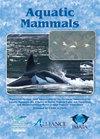鲸类动物声学监测的强化解释:研究影响美国南卡罗来纳州查尔斯顿港城市化河口大西洋宽吻海豚发声模式的因素
IF 0.9
4区 生物学
Q4 MARINE & FRESHWATER BIOLOGY
引用次数: 1
摘要
查尔斯顿港在南卡罗来纳州(SC)是一个主要的港口,经历了高水平的船舶交通。对沿海宽吻海豚(Tursiops truncatus,现为Tursiops erebennus)目击的历史分析发现,港口内多个核心使用区域与这些人类活动重叠。根据这些长期空间数据,从2017年12月到2019年6月进行了被动声学监测、视觉调查和猎物抽样,以评估可能影响海豚发声模式的关系和多元相互作用。鸣声在空间和时间上都存在差异,在秋季和冬季达到峰值,与水温和白天时间的下降相一致,这与之前在其他SC河口报道的模式一致。海豚的猎物和总鱼类丰度随着水温的升高而减少,这可能表明海豚在猎物稀少、发声物种较少的冬季更频繁地进行回声定位和鸣笛。海豚的目击和发声高度相关。在库柏河和万多河汇合处附近的航道附近,海豚的发生率最高,在那里发现船只和发出声音的鱼类最多。当船只的噪音发生时,海豚会增加它们的发声,这表明这个种群可能会改变它们的声音储备,以应对不断增加的噪音水平。多元相互作用表明,发声率的强烈空间和季节模式可能与海豚和猎物的丰度以及噪声诱导的冗余有关。本文章由计算机程序翻译,如有差异,请以英文原文为准。
Enhancing Interpretation of Cetacean Acoustic Monitoring: Investigating Factors that Influence Vocalization Patterns of Atlantic Bottlenose Dolphins in an Urbanized Estuary, Charleston Harbor, South Carolina, USA
The Charleston Harbor in South Carolina (SC)is a major port that experiences high levels of vessel traffic. Historical analyses of coastal bottlenose dolphin (Tursiops truncatus, now Tursiops erebennus) sightings identified multiple core use areas in the harbor that overlap with these anthropogenic activities. Informed by these long-term spatial data, passive acoustic monitoring, visual surveys, and prey sampling were conducted from December 2017 to June 2019 to assess the relationships and multivariate interactions that may influence dolphin vocalization patterns. Vocalizations varied spatially and temporally, peaking in fall and winter months coinciding with decreases in water temperature and daylight hours, following patterns previously reported in other SC estuaries. Dolphin prey and total fish abundance decreased with water temperature, which may indicate that dolphins echolocate and whistle more frequently in the winter months when prey are scarce and sound-producing species are less soniferous. Dolphin sightings and vocalizations were highly correlated. Dolphin occurrence was highest in the areas surrounding the confluence of the Cooper and Wando Rivers, along the shipping channel, where vessel and sound-producing fish detections were greatest. When vessel noise occurred, dolphins increased their vocalizations, which suggests that this population may be modifying its acoustic repertoire in response to increased noise levels. Multivariate interactions indicate strong spatial and seasonal patterns in vocalization rates that may be associated with dolphin and prey abundance as well as noise-induced redundancy.
求助全文
通过发布文献求助,成功后即可免费获取论文全文。
去求助
来源期刊

Aquatic Mammals
MARINE & FRESHWATER BIOLOGY-ZOOLOGY
CiteScore
1.60
自引率
16.70%
发文量
99
审稿时长
>12 weeks
期刊介绍:
Aquatic Mammals is a peer-reviewed journal sponsored by the European Association for Aquatic Mammals (EAAM), the Alliance of Marine Mammal Parks and Aquariums (AMMPA), and the International Marine Animal Trainers’ Association (IMATA). Aquatic Mammals publishes articles related to marine mammals (whales, dolphins, seals, fur seals, sea lions, walrus, dugongs, manatees, sea otters, and polar bears). Topics of publication on both captive animals and wild marine mammals include aspects of husbandry; behavior; conservation; veterinary medicine; anatomy; physiology; training; population trends; and the effects of pollution, climate change, and noise.
 求助内容:
求助内容: 应助结果提醒方式:
应助结果提醒方式:


